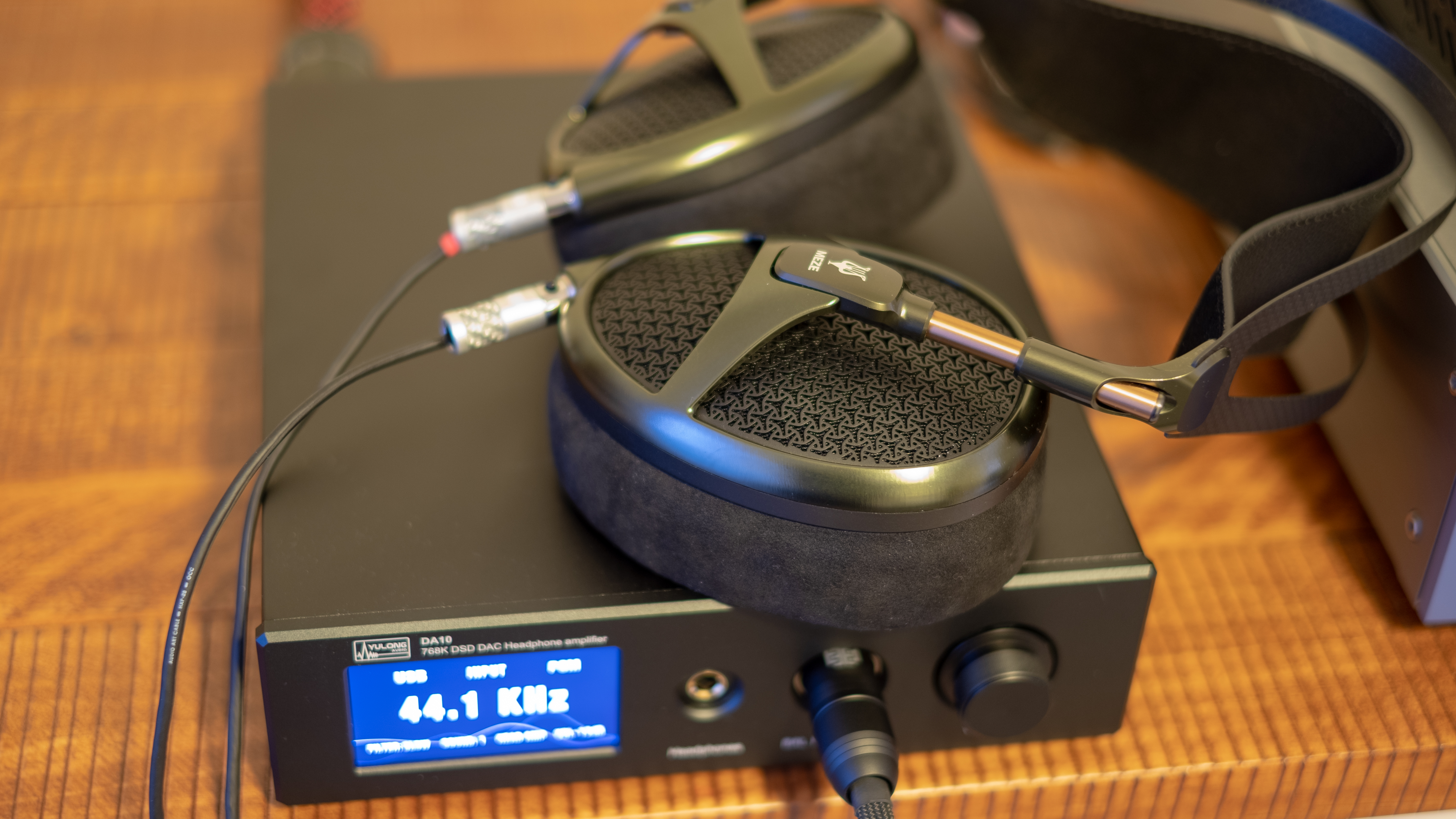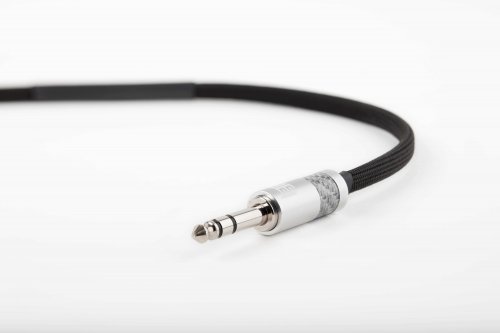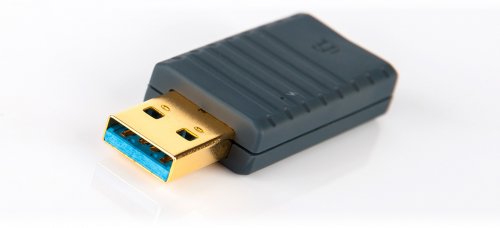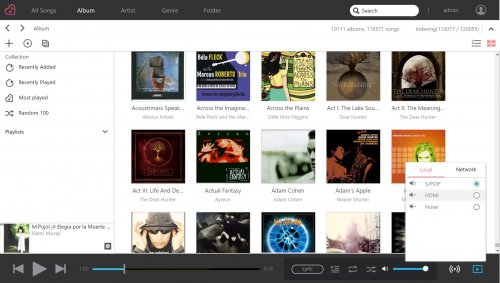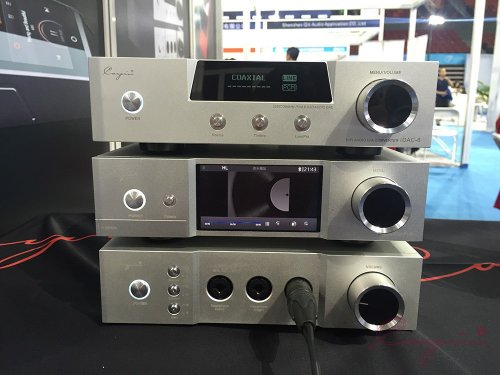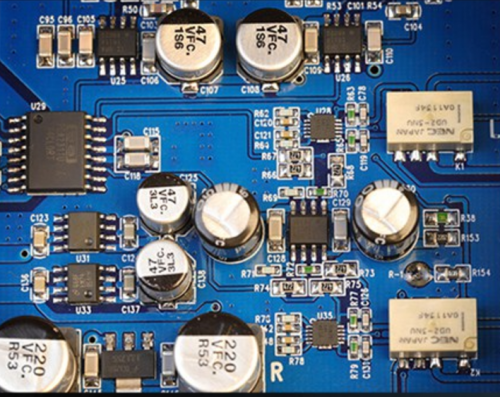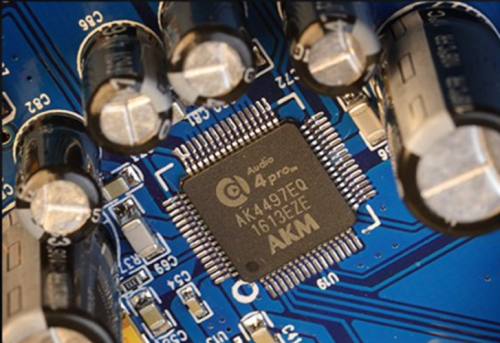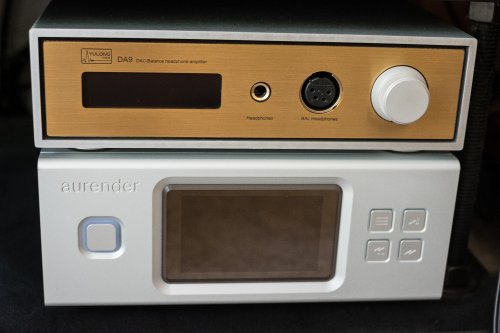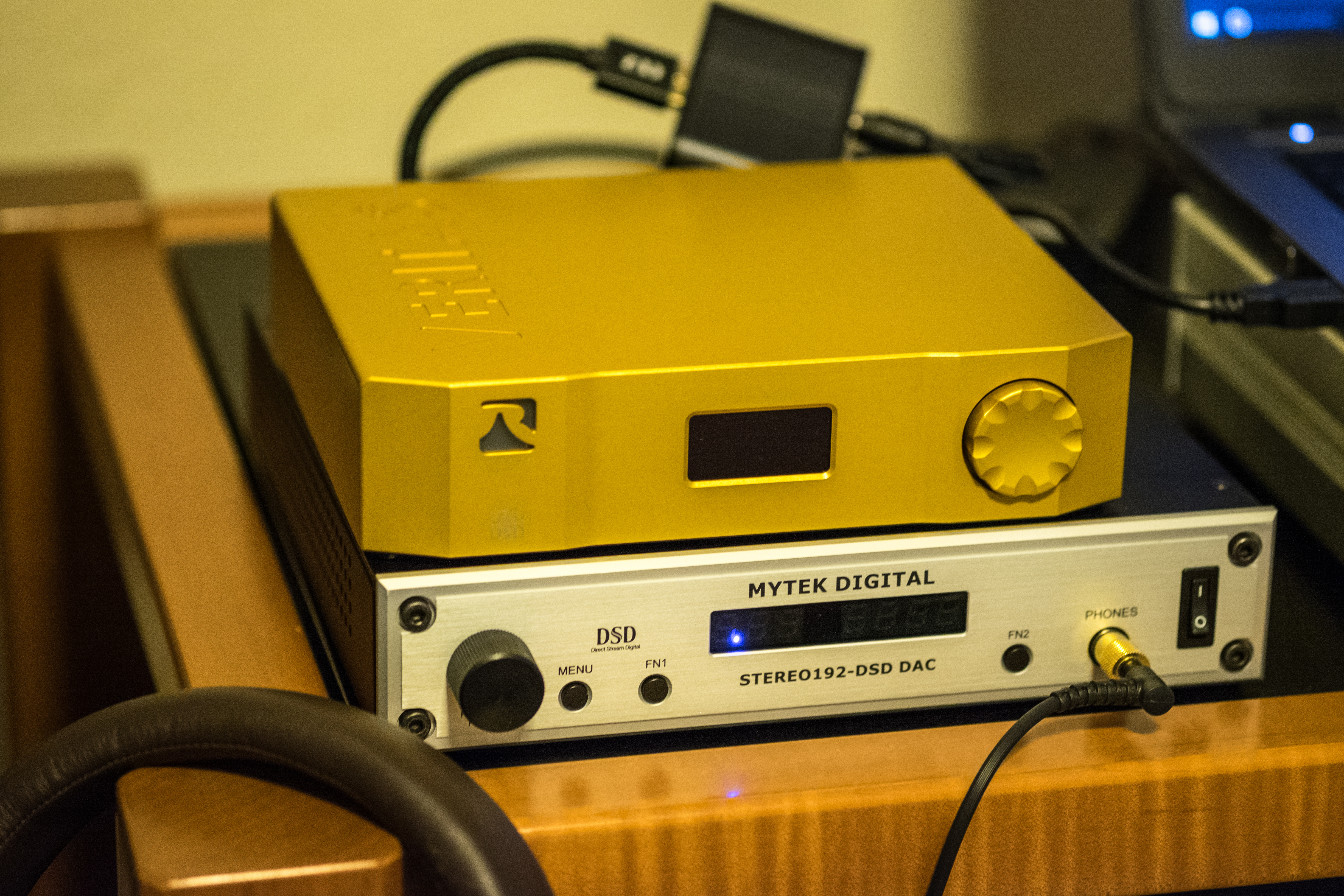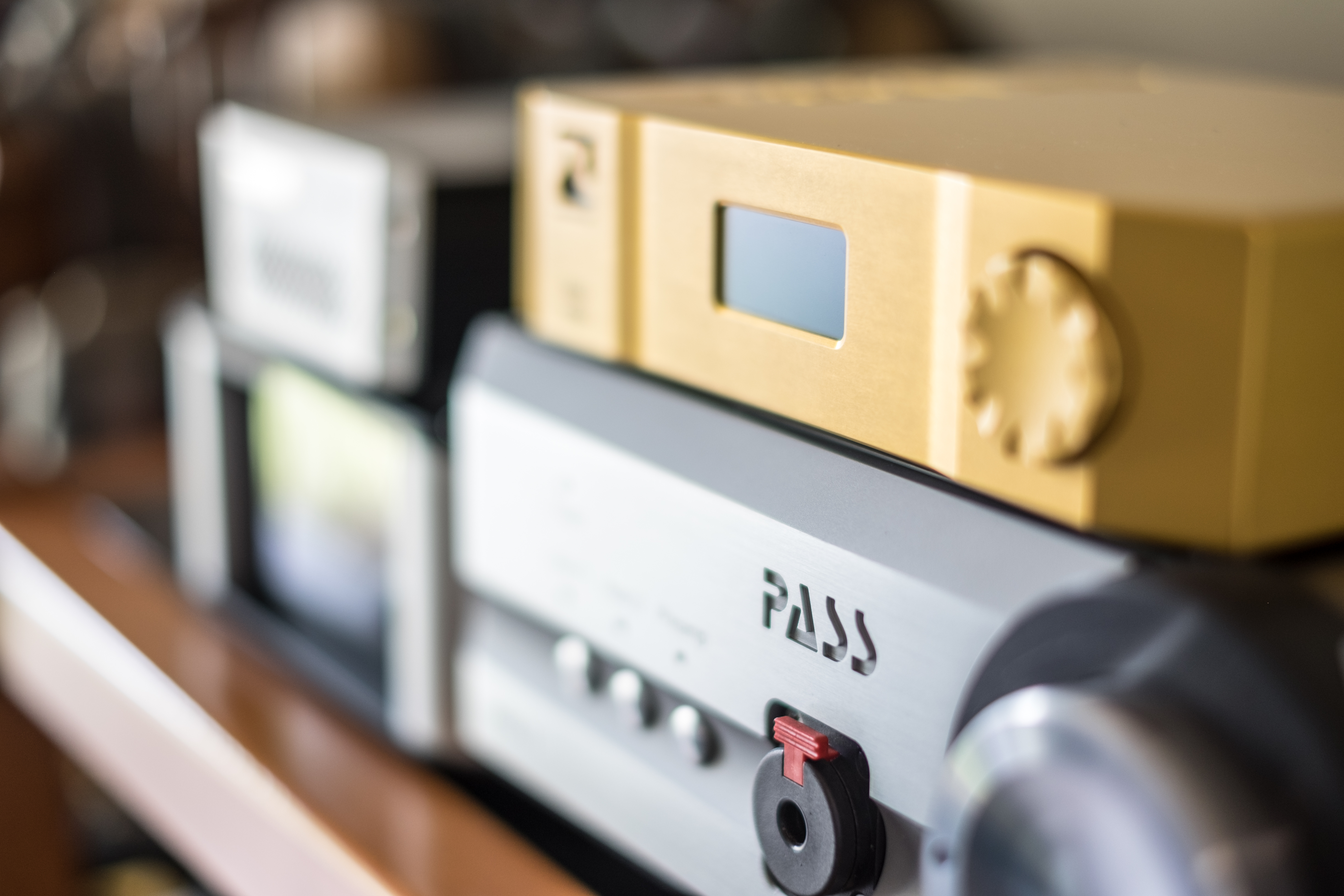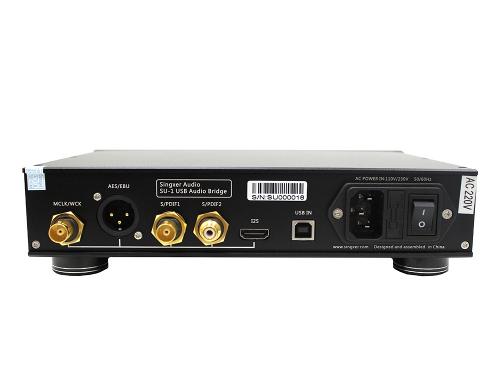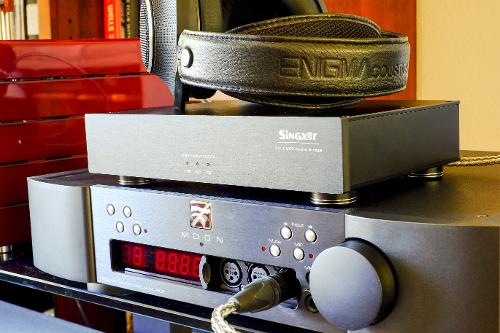Veritas.
Latin for
Truth.
In a perfect world, this describes the ideal source component for quality audio reproduction. Convert those ones and zeros faithfully, making an honest representation of the original source material, and send that resulting analog signal out to a gain stage. Simple, right? And yet here, in the real world, it doesn't seem to be quite so easy. Take a look at the many hundreds of current designs, using different and often contradictory approaches to achieve the same goal. That number balloons much higher if we include out-of-production models. And that's not to mention the designs which aren't even looking for truth - instead actively seeking to put their own coloration on the sound. The options can be overwhelming.
My personal weapon of choice for musical truth since 2011 has been the Invicta DAC from Resonessence Labs. I've tried many dozens of competitors during that time frame, and none seem to have the same sense of clarity, spaciousness, or tonal accuracy. Some, like the BMC UltraDAC, do an exceptional job in their own way, and I've got a list of favorites covering a wide range of prices. But if I have to choose just one, Invicta remains my favorite.
Resonessence Labs initially launched the Invicta at $3999. Since then, the device has evolved from original to v2 to Mirus to Mirus Pro, bringing significant sonic improvements with each step. These updates, combined with inflation, have pushed the price up to $5999. Not the most expensive DAC in the world by any means, yet still high enough to be out of reach for a large number of enthusiasts. Resonessence Labs needed something more affordable to expand their user base.
This was accomplished with the Concero line ($850) and the diminutive Herus ($350), which put Resonessence quality in the hands of many. I enjoy these affordable models immensely, each in its own way, and find them very competitive in their price class and beyond.
And yet... there's an obvious and rather large gap in the middle there. For years, folks have been hoping for a stripped down Invicta with a lower price tag. The formula seemed obvious - remove the SD card playback function, lose the integrated headphone amplifier, reduce the connectivity options (Invicta has 7 digital inputs, which is more than most people need), and perhaps simplify some internal design aspects, all while preserving as much performance as possible.
I'm happy to say that with the
Veritas, Resonessence Labs has done just that.
At $2850, Veritas is less than half the price of its older sibling. It shares quite a bit of the Resonessence design language though - an attractive milled aluminum enclosure with surprising heft, an OLED display, a "clickable" scroll wheel for navigation, Apple remote compatibility, and a generous array of inputs and outputs. Internally, we get several custom Resonessence Labs filters, their proprietary FPGA engine, and custom USB code executed on a Cypress semiconductor chip rather than the usual suspects from XMOS or Amanero. This is stuff you just won't find anywhere else. And not that it matters much by now, but Veritas was the very first product on the market using the new ES9028Pro DAC chip, thanks to the uniquely close relationship between ESS and Resonessence Labs.
The resulting sound is very much in the same spirit as the Invicta. Words like clean, clear, accurate, and neutral all spring to mind, but don't think for a second this is an overly dry, polite DAC. Veritas has bass depth for miles, and a sense of tonal accuracy matched by very few competitors. The resulting sound is one that I'd place on the same performance tier as the Invicta "v2" from a few years back, prior to the Mirus upgrade which doubled up on the number of DACs per channel (from 4 to 8). This is quite an accomplishment from a device with reduced complexity, size, and price.
And that's where I'll stop. Rather than have me go on and on about the performance of the Veritas, I'm going to switch things up and focus on comparisons. I've had a massive amount of DACs come through the house over the last year or so. Many of them are devices which compete directly with Veritas based on price or feature set. Others are helpful just to give a sense of where the Veritas falls on the sonic spectrum, even if their price is significantly higher or lower.

A quick aside about color choices: Veritas is available in silver, black, and the interesting gold color as seen in my review unit. It's hard to accurately capture the proper color as it tends to look different based on lighting. At times it seems more rich and dark, while other times a sort of pale yellowish hue emerges. You'll see that in my pics, though some variance may be due to editing to bring out maximum clarity. In my humble opinion, this thing looks fantastic in gold. I wish I had my old Sonic Frontiers transport with the gold face - that would be a stunning combo. Most people would probably be more inclined to stick with traditional colors but I'm glad Resonessence Labs gives us the option.
The main system used for these comparisons, down to the excruciating details for those who care:
SOURCES: Aurender X100L, Singxer SU-1, Examplar modified Oppo BDP-93, SOtM sMS-200 and Wyred 4 Sound Recovery both powered by Wyred 4 Sound PS-1
AMPS: Pass Labs HPA-1, Violectric V281, Cayin HA-1A mk2 (with Amperex Bugle Boy 12AU7s, Hammond-branded Amperex 6BQ5s, and Tung-Sol 12DT5, all NOS tubes), Arcam rHead (used mainly with IEMs), custom-built high-bias KGSShv (for Stax, obviously)
HEADPHONES: Sennheiser HD650 and HD800, HiFiMAN HE-1000, Enigmacoustics Dharma, Audeze LCD-3, Stax SR-007mkII and SR-4070, Empire Ears Zeus XR ADEL, Noble K10, NG Audio Capricorn, Jomo Audio 6R
ANCILLARIES: Equi=Core 1800 balanced power conditioner, BMC PureUSB active USB interface, Better Cables Blue Truth II and Silver Serpent interconnects/digital cables, Cabledyne Silver Reference AC cables, Zoethecus rack with Z-Slab shelving
There were also times when I used a wide variety of other components - the above is just the stuff I tended to use most.
All comparisons were done with both units on hand for direct back and forth, though I had more time with some of them than others. So there will be certain entries with more info and some with less. This is going to be more stream-of-consciousness than my usual review style - hopefully a clear picture will emerge.
Mytek Stereo192 DSD ($1695)
Released back in 2011, this device is a bit long in the tooth considering the rapid pace at which DACs are moving. While the front panel looks quite modern (only on the silver version though), a Firewire port around back lets us know we're dealing with semi-vintage equipment. Still, it's a very widely used device in my experience, so it makes for a good benchmark (no pun intended).
I'm convinced there must be some major unit to unit variability going on with this device. I've heard several examples over the years and to be completely frank, they sounded terrible. Thin, brittle, shouty, with an odd cardboard-cutout soundstage. I couldn't fathom how anyone could enjoy that type of sound, but.... different systems, different ears, etc.
Fast forward to last year, when a friend brought one over and said "try this out". I wondered what I had done to offend him - then I plugged the thing in and had a listen. To my surprise, this was a perfectly enjoyable DAC. It had respectable detail that was not annoyingly bright, a more fleshed out tone, and a reasonably defined soundstage that did
not sound completely artificial. This was a total night and day transformation compared to the last examples I spent time with. I don't know if there was A) a silent refresh to the design at some point, or B) this was just a particularly good example, or C) the others I tried were extremely poor examples. Whatever the case, if this is how at least
some of the units sound, I better understand why the device became popular.
While I did enjoy this particular Mytek more than the others, I still didn't find it anywhere near the level of the Veritas. It had a certain sterility to it, a sort of artificiality which never managed to go beyond "a good approximation" of real instruments. Again, it was reasonably enjoyable for the most part, but Veritas was far more convincing. The better the system, the more obvious this improvement became.
In terms of balance, the two weren't drastically different, though Veritas did manage significantly more low end gusto. The Mytek felt like it gracefully ran out of steam in the bottom octaves, almost as if listening through a quality mini-monitor instead of a true full-range speaker. Leading edges initially seemed fast on the Mytek yet on direct comparison seemed overly vague, with Veritas being more dynamic and well defined on guitar picks and percussion strikes. This may sound like audiophile nit-picking but I think most listeners would pick up on it pretty quickly, and enjoy Veritas more.
Ultimately, I'd say Veritas would be a logical upgrade for those who enjoy their Mytek (which I have to assume means a "good" Mytek, otherwise I can't relate at all) but want to upgrade to something better without a fundamental change in character. Veritas is similar enough while doing pretty much everything better.
Mytek Brooklyn ($1995)
This can be considered the successor to the Stereo192 DSD which appears to be discontinued at this point. I've only heard one example of the Brooklyn, and my experience with it was reasonably positive overall. I can't say if all examples sound the same but for now let's assume they do.
Used purely as a DAC, this thing is pretty enjoyable before factoring in price or doing any comparisons. It has a neutral and nimble presentation with a nice improvement in treble clarity over the old model. After spending more time with it, I discovered that while perceived detail was high, it was also slightly exaggerated. This initially made it sound
extremely resolving, when it reality it is not quite up to that level. Still, it's far less offensive than the Stereo192 which retained an etched feel even on the "good" example.
Midrange on the Brooklyn is less involving than I'd like, and consequently I found myself connecting with the music less than I do with Veritas. This was not immediately obvious but became clear after extended listening, and even more so during back to back comparisons. Veritas also has a larger sense of scale to orchestral works and other large presentations. While Brooklyn does an acceptable job here, and even beats some more expensive competitors (Bryston for example), Veritas clearly stands out as being more spacious and three dimensional. It's a physically smaller DAC that makes a rather large sound.
Overall, Brooklyn sounds enjoyable enough, and it's a definite step up for Mytek. I think most people would have a reasonably good time with it in most systems. Unfortunately, the value just doesn't seem there. That may sound odd considering it packs a built-in headphone amp and preamp functionality complete with phono stage. Sounds like a very well-rounded package, right? For $850 less than Veritas, you get more bang for your buck.
Or do you? This extra stuff is only worthwhile if the user takes advantage of it. The DAC is pretty nice but the headphone amp is thoroughly mediocre in my opinion. The little Arcam rHead ($599) is FAR better, as is the integrated headphone out on the diminutive Grace Design m9XX ($499). The DAC/amp combos I'm used to in the $1K to $2K range - Anedio D2, NuPrime DAC-10H, BMC PureDAC - are all substantially better than Mytek's offering, which comes across as sterile and boring. To be fair, it's better than the Stereo192 was, but that's not saying much.
I don't do vinyl but I suspect most aficionados would prefer their own phono stage. I can't really comment on that though. I
will admit the preamp functionality is very well done. That may actually be the best part about Brooklyn. Veritas does fine going DAC direct but loses tonal richness as volume drops - a problem the Mytek does not seem to have. So Brooklyn may rightfully have some appeal to speaker listeners wanting to ditch their dedicated preamp.
Still, the core functionality here is bringing bits to life, and in that respect Brooklyn is what I'd call good, but not quite great. Which is why I find it overpriced in the end. Yes, Veritas does indeed cost more and offer less functionality, but it really nails the critical DAC aspect, which in my mind is by far the most important part.
As an added wrinkle to this already complex comparison - I had a chance to briefly run the Brooklyn with an external linear PSU, and it seemed to really help. I used a Wyred 4 Sound PS-1 modular PSU with the high-current amp module but unfortunately only had a brief listening session with it. I had already committed to shipping the DAC back to its owner when the PS-1 arrived so the timing just wasn't right. I can't really say how the resulting sound stacks up to Veritas but it did seem more competitive. There was a distinct improvement in tonal richness which really helped flesh out the performance and make it more engaging. The Wyred PSU upgrade goes for $900, which would bring Brooklyn up to almost exactly the same price as Veritas, so that's something to consider.
BMC UltraDAC ($3990)
This is one of my favorite DACs, probably second only to the Invicta. I tend to like it more than the Veritas in certain situations, but not always. The UltraDAC reminds me of my favorite older DACs such as the Classe DAC-1, which I regret selling to this very day. It has a somewhat more "musical" sound, deviating from pure neutrality with just a hint of warmth and a very slightly smooth top end. It's more dynamic and alive while Veritas tends towards matter-of-fact realism, if that makes any sense. I do have to stress that while Veritas is more straight-forward neutral, it does
not cross the line into being clinical or cold like the Benchmark and even Vega sometimes can. Unless of course you pair it with overly bright amplification and headphones while playing aggressively mastered recordings. Then all bets are off.

System synergy really comes into play as to which DAC I'll prefer in a given situation. As does musical choice. The BMC excels with classic rock, funk, blues, reggae, and hip hop. Not that Veritas isn't appealing with those genres, but if I'm in the mood for King Crimson, Aesop Rock, Ohio Players, Albert King, or Matumbi, I'd generally prefer having UltraDAC in the chain, depending on the rest of the system of course. If, however, I feel more like playing some Crooked Still (bluegrass), Quo Vadis (technical melodic death metal), Rameses B (drum/bass), Yuna (pop), Starcadian (retro-synth goodness), JJ Heller (girl-with-guitar), or Stravinsky (duh), I would most likely go with Veritas as my preferred presentation. But again, the BMC DAC sounds great with these too.
In terms of value, this is a tough comparison. BMC has a very good integrated headphone output - particularly via the balanced output - which is among the very best I've heard from a DAC/amp combo. It also does a more satisfying job at replacing a separate preamp when listening at low volumes. Running direct to a speaker amp - if I stick with moderate or loud listening, Veritas is quite good. It just doesn't quite keep up with the best competitors at lower levels.
In the end, two questions remain when comparing these DACs - 1) are you shooting for strict accuracy, or would you prefer a small bit of euphonic coloration? And 2) how much is an excellent headphone jack and superior preamplification worth to you?
Benchmark DAC 2 HGC ($1995)
Benchmark now has a newer, slightly more expensive DAC 3, released just a few months back at time of writing. Unfortunately I have not yet experienced that model. Many people are familiar with the DAC 2 though, so it still makes for a relevant comparison. And from what I can tell, the DAC 2 will continue as a current model alongside DAC 3 - at least for a while anyway.
I think Benchmark is interesting. For years, engineer John Siau stood by his original DAC 1 design as being essentially perfect. He didn't feel asynchronous USB was necessary, as his design was effectively "jitter-immune". He felt measurements told the whole story, and that any device which
did measure better than the DAC 1 was beyond the reach of human ears anyway. He also seemed to think the DAC 1 headphone output was completely transparent - a sentiment which strained credulity with a good number of headphone users.
That left him in a bit of a pickle when it came time to finally market a new and improved model. As you can see
HERE, he eventually got on board and conceded there
may be a few small areas of improvement on the DAC 2 which are in fact audible. I haven't had time to look into the DAC 3 much but I notice Benchmark
claims its improvements are directly related to using the new ES9028Pro chip. Make of that what you will.
In terms of sound, the DAC 2 is a very big improvement over the old model. This is similar to Mytek's jump from Stereo192 DSD to Brooklyn - a very large, very welcome improvement. But once again, I still find the Veritas to have more compelling sound overall.
While DAC 2 significantly improves the etched, grating upper midrange and glassy highs of the original, some room for improvement remains. Veritas is in another league, with liquid highs that extend indefinitely without causing the same listening fatigue over time. I connect with the music on a deeper level when it sounds utterly natural and unforced, and the DAC 2 doesn't quite manage that on a consistent basis.
I definitely hear a big improvement in harmonic richness over the DAC 1 - there's just more convincing tonal weight to the presentation this time around. But again, it's still not on the same level as Veritas, which sounds like real life to me - I know I keep saying that, and it's probably not in the approved audiophile lexicon, but it captures what I'm experiencing in a way most people should understand. The DAC 2 still sounds thin and clinical by comparison.

The Benchmark has a headphone amp which I'm assuming carries over from the original model. It thus shows improvement due to the DAC section's elevated performance, but as a whole still seems underwhelming. It's a technically proficient sound that lacks soul, much like the amp stages found in the Antelope Audio and Mytek DACs (though admittedly Benchmark is less obnoxious than either of those). I've had people tell me these things are just brutally honest, and I must be looking for some coloration or pleasant distortion. I've enjoyed plenty of extremely neutral amps, from my reference Pass Labs HPA-1 to the integrated headphone out on the Anedio D2. Trust me when I say the amp stages from Mytek, Antelope, and to a slightly lesser extent, Benchmark, are not on that same level.
Back in the day, I'd hear people say they enjoyed their warm, syrupy NOS DAC with tube output stage better than the DAC 1. And while I could identify with that to some degree, I couldn't help thinking that the Benchmark should get points for at least
attempting to be the more honest presentation. It wasn't perfect by any means, but many of the popular alternatives were a major overreaction in the other direction. I don't want anyone to think Veritas is anything like that. It sounds to me like Benchmark set out to achieve a certain goal on the DAC 2, and couldn't quite get there. It's the same sound they've been shooting for since the original DAC 1 (which fell significantly shorter) and I do think it's a worthy goal . Veritas pulls it off. It's a series of smallish improvements over the DAC 2 adding up to something very worthwhile in the end, which is why I can handily recommend the Resonessence Labs device over the Benchmark.
I do very much want to experience the DAC 3 though, as I feel the company is on the right path (finally).
Audio GD NFB-7.38 ($1538 plus fairly hefty shipping cost)
I'm not sure what's going on a Audio GD. Back in the day I had a great respect for their sound quality - the Reference 1 and particularly Ref 7.1 were excellent DACs which I found very easy to enjoy. They weren't exactly cheap, but could rightly be called a good value for the money. Those evolved to the Master 7 which increased cost without adding much sonic improvement - at least, not much that stood out during my somewhat limited time with it. Now the Master 7 Singularity version costs even
more, and again doesn't really stand out compared to my memory of the older models. Perhaps this is just nostalgia at work, or maybe the improvements mainly addressed the USB input which I didn't really make use of. Whatever the case, I'm not really impressed with the direction I'm seeing from Audio GD.
And then there's the new Singularity 19 which to my ears sounds fundamentally broken. Enough said.
The last model I had a chance to try was the NFB-7.38 - a unit which sports the top of the line ES9038Pro chip along with typical Audio GD beefy design. I don't know if it came out before or after the Singularity 19 as the Audio GD line is constantly in flux. At a price approaching $1700 after shipping, yet with a flagship ESS DAC on board, I was hoping this thing would match the value proposition of the older models. I was wrong.

The 7.38 seems lacking in a way I find hard to describe. While not being thin and brittle like the older Mytek, or lacking involvement like the Benchmark, I nevertheless found it difficult to enjoy this device in my system. It just didn't engage me as the older PCM1704 based models did. Those had a sense of drama and dynamics which couldn't be ignored. This new model seems overly subdued, with a sort of nonchalant presentation that just says "meh". There's a certain softness of note which dulls transient attacks, yet doesn't result in a smooth, relaxing presentation like the original DAC 19 (a warm, musical model which I did enjoy). To my surprise, soundstage remains nicely open and spacious, though a bit lacking in depth, and imaging is fairly precise too. This is not a terrible DAC by any means... it just doesn't engage me as much as I'd like. As I said, it's hard to describe.
It feels wrong to put the little Veritas up against this behemoth. You could stuff four of the Resonessence DACs into the Audio GD enclosure - with room to spare. The Chinese device uses a higher-end Sabre DAC and a
much more complex power supply - if we assume a higher parts count equals a more advanced design.
And yet, when I listen back to back, I can't help but find myself far more interested in the Veritas. It's more incisive, transparent and clear, which I sort of expected, but it also digs deeper on the low end, and has a more palpable, rich midband. In short - I can't find any single area in which I prefer the Audio GD, other than perhaps when playing poor recordings that I want to cover up. But I can think of far more effective "sonic band-aid" DACs which don't cost anywhere near as much as the NFB-7.38.
I still think some models in the Audio GD lineup hold promise. I'd love to see the company settle down, stop offering revisions every twelve months, and maybe focus on just a few models instead of the wide range they currently have. But as far as I'm concerned, the NFB-7.38 is not worth the money.
Chord Hugo TT
Hugo is a perfect example of the what is often called "hype" on the forums. For a certain period of time, Hugo was considered by many to be unbeatable, at any price. A true giant-slayer. Folks who disagreed were simply wrong. Then came the much less expensive Mojo and significantly more expensive Hugo TT, which (each in their own unique ways) made people realize the original Hugo perhaps wasn't perfect after all. Now the
very expensive DAVE is the current "it" product. You'd better love the oddly named/styled device, lest you lose forum credibility.
Personally, I rather enjoyed Hugo for its expressive sound, but
hated the ergonomics of it. I also found plenty of ways to assemble a system where Hugo sounded pretty poor. "Threadbare" was the term I used. Everything had to be just so - great recordings, neutral or warm amplification, and headphones that aren't at all bright - in order to get a result worth listening to. If not, it lacked
impact, and I don't just mean low frequency performance.
Chord's Hugo TT ($3995) solves a lot of the issues I had with the original Hugo. The questionable design and build aspects are gone, and in their place is a very well thought out enclosure with appropriate build quality for the price. I seem to recall Chord originally saying the sound would be practically identical to Hugo, but later statements point to improved SQ so I could be misremembering.
Taking the TT as a unique product unto itself, the result is what I'd call "competitive" for the price if not quite revolutionary. The sound is a bit more full bodied than the original Hugo but still lighter and more wispy than I like in some instances. To put things in perspective, Veritas seems less sensitive to system matching than Hugo TT. While both models could be described as neutral or even bright in some situations, Veritas seems more consistently enjoyable across a wide range of associated gear. Hugo TT has potential to sound quite nice but pairs better with more tonally rich amps and headphones. And that built-in headphone output exacerbates the issue. Running HD800 or Enigmacoustics Dharma straight from the jack is a recipe for boredom in my opinion. HD650, Fostex TH-X00, or the Noble K10 all make far better matches, though I still find the BMC UltraDAC far more satisfying as an all-in-one solution.
In the end, Hugo TT is probably worth a look for some people, despite not being my favorite. If you value that colder, somewhat sterile sound, Hugo is better than the Mytek or Benchmark devices, though it costs significantly more as well. Veritas matches and even exceeds the TT's capabilities with respect to microdetail and imaging, while steering clear of being overly analytical, and that makes it the better choice for my preferences.
Exemplar modified Oppo BDP-93 ($2500)
Not many people have heard this device but I wanted to throw it in here anyway just for fun.
This is an Oppo BDP-93 universal player with numerous upgrades by John Tucker at Exemplar Audio. Most of it pertains to power supplies and output stages - very little is done to the actual digital circuitry (which is why I find this comparison so interesting). The sound it produces is slightly thick, warm, a bit on the smooth side, and
very dynamic, even if not the most resolving I've ever heard. It's pretty amazing how much SQ they tease out of this device - remember, we're talking about the Oppo 93 rather than the more audio-oriented 95. Despite its humble origins, I'd take this modded 93 hands down over the stock 95 or 105 (I have yet to hear the newly-launched 205). It comes surprisingly close to the tube-modded Oppo "Truth" series from Modwright, which are quite a bit more expensive and complex.
Veritas has a very different presentation compared to the Expo 93. I doubt anyone would ever confuse the two. This could be rightfully be considered a more colored presentation, which is normally something I shy away from. But damn if it doesn't make everything it plays sound pretty spectacular... just a rich, meaty tonality with excellent weighty low-end impact and a flowing, liquid midrange. It's got nice clean upper mids and then a gentle slope to the treble, so it still presents as being reasonably detailed yet also smooth at the same time.
When paired with the right supporting gear - the Violectric V281 makes a perfect dance partner, particularly when driving Audeze LCD-3 or HiFiMAN HE1000 - this thing just grabs me and refuses to let go. In contrast, Veritas is much quicker, more resolving, and plays far deeper into the recording. It matches and often exceeds the Expo bass slam, but you don't really notice due to the more balanced presentation. Piano strikes, cymbals, brush work, and female vocals all show vastly more shimmer and sparkle via the little Resonessence device. Like I said, totally different presentations. To put it in more familiar terms - the Expo 93 reminds me of a Cowon Plenue 1, while Veritas is better represented by the Sony ZX2.
I find this comparison interesting because these two machines approach from completely different angles. The Expo doesn't have the latest in high-end digital. In fact it uses a good-but-nothing-special Cirrus CS4382 8-channel DAC, carried over from the older Oppo BDP-83. For those who recall, Oppo gave the 83 a separate set of 2-channel outputs driven by a CS4398 DAC - the top model in the Cirrus stable. Many sources online attribute a similar setup to the 93 but I've cracked the case open and don't see a CS4398 anywhere. Nor are there dedicated 2-channel outputs separate from the 7.1 analog outs on this machine. Repurposing multi-channel DACs for stereo operation was not all that common until the ESS chips made it simple to accomplish, so I doubt Oppo or Examplar has this running in dual or quad mono (like many Sabre designs these days). No, this is a fairly plain DAC implementation using 2 of the available 8 channels, which is just "good enough". Instead, the device relies heavily on power supply upgrades, shunt regulators, upgraded capacitors, and opamp swaps with class A biasing. Nothing revolutionary by any means, yet the sonic result is very pleasing.
Contrast that with the Veritas which goes smarter rather than more complex in the traditional sense - it almost seems too simple until you remember the custom USB code, that FPGA engine borrowed from Invicta, and those proprietary digital filters. Some audiophiles would scoff at the lack of a huge regulated linear power supply and discrete output stage, but the resulting sound speaks for itself on this little device.
The Expo seems limited by its rather pedestrian DAC section, which I suspect holds it back from achieving true greatness as far as treble, imaging, and soundstage. Instead, it is wisely tuned for a somewhat smooth, forgiving presentation up there, where errors of omission don't distract. The Veritas is far more capable in that aspect, resolving gobs of details the Oppo misses. On the other hand, one might think the Oppo would posses a natural advantage in things like bass slam and dynamic authority - hallmarks of a stout, well regulated PSU. Yet Veritas keeps up and even surpasses the Oppo in its theoretical strong points.
The conclusion here is that you can go a long way with more "traditional" audiophile design concepts, as Exemplar has done on this device, though forward thinking engineering with a strong focus on the digital side can surpass those achievements. Obviously this doesn't
always happen, but in this case I'd say it does.
PS Audio DirectStream Junior ($3999)
I have a mixed history with PS Audio. Some of their gear has left me totally cold (the Sprout, and the original NuWave for example, neither of which I enjoyed in the least), while others I've quite liked (the PerfectWave DAC and transport as well as the older Digital Link III). Even when I do enjoy their stuff, I tend to find it overly expensive - the flagship DirectStream falls into that category. It's an excellent sounding DAC, but even so, $5999 seems a bit steep.
The DirectStream Junior cuts that price by $2K while sounding nearly identical to my ears. There
is a difference, but I find it small enough not to matter for the vast majority of listening. Junior also adds network functionality with Roon compatibility which is a huge deal for me. Users of the big DS Senior need to purchase the Bridge II separately to get this same feature, to the tune of $899. So realistically the Junior saves almost $3K compared to a similarly equipped Senior model.
On sound, I find the Junior highly enjoyable. It actually sounds quite similar to Veritas in a lot of ways. Both do cymbals and brushwork in a very convincing manner. Both have very open, airy presentations, with Veritas taking a slight edge in terms of specificity and soundstage depth. Both dig extra deep on the low-end, being authoritative yet uncolored by unnecessary exaggeration. And both can do massively complex orchestral works without breaking a sweat.
Where I found them to deviate is with regard to detail. Veritas is a bit more focused on micro, while Junior has more of a macro-oriented presentation. This initially led me to find Veritas brighter and Junior more dynamic - a good summary which doesn't really capture the whole truth. After much more listening, I don't think Veritas is necessarily brighter so much as it is more
incisive with the tiniest details
. And while the Junior is certainly dynamic, it doesn't really do much that Veritas doesn't do... it's just the focus is shifted based on the different signatures. They both sound excellent in their own slightly different ways.
In the end I could happily live with either of these devices in my reference system. Veritas is more affordable at first glance, but to match the Junior with Roon streaming I need to factor in my SOtM sMS-200 powered by the Wyred 4 Sound PS-1 - which brings the prices pretty much in line with one another.
While stepping up to the top PS Audio model costs lots of money for minimal gain, Resonessence Labs offers substantially more when upgrading from Veritas to Invicta Mirus Pro. But that's a story for another day.
Auralic Vega ($2799)
Vega is a very popular and well known DAC, which most people seem to respect - even if they don't quite love its signature. Until recently, it sold for $3499, but with the new price cut it matches the Veritas almost exactly. Technically speaking, this is probably a soon-to-be-discontinued item, as Auralic has the new Vega G2 coming down the pike. That model will cost substantially more ($5600) putting it in a whole different class. Many Vega users can't or simply won't go that high.
Still, the original Vega is an enjoyable device with plenty of life left in it. It's got a quicksilver presentation with what I initially hear as extreme amounts of detail, along with a slightly lean but wonderfully textured midrange and textbook low-end accuracy. No doubt about it, this is a high performance device.
I mentioned how I "initially" thought the detail levels were higher. After lots of listening, I've determined the Vega does some interesting things in that area. There's a bit of an artificial "push" to it, where the device seems to be trying overly hard to produce extreme clarity. It works pretty well at times, and often sounds stunning on demo tracks or during quick listens. I can see people being easily sold on this device when auditioning at a dealer.
When you get it into a familiar home system and spend more time listening with well-known tracks, something else begins to emerge. I get the impression of a sort of unnaturally "forced" feeling on the upper midrange and highs when using Vega. It's like the DAC is trying really hard and straining itself in the process. I know that's a weird description but it's the best I can do. Individual notes still come out clean enough, but somehow the entire thing doesn't sound natural when taken as a whole. Veritas does not suffer this problem at all.
The best analogy I can think of - and it's still a flawed one, to be sure - is listening to pop artists like Kelly Clarkson, Pentatonix, Dami Im, etc. Beyond all the vocal processing and studio trickery, these folks are still quite talented as singers. But in my humble opinion they all try
way too hard much of the time. Listen to Kelly Clarkson's Christmas album
Wrapped in Red and you'll hear exactly what I'm talking about. She goes pedal to the metal far more often than one would expect - which doesn't exactly fit with some of the material on this album. It sounds impressive at first but gets old rather quickly. I suppose when you came up competing in talent shows, you become accustomed to showing off a bit. Or maybe I'm just an old curmudgeon and this is how things are done these days.
In any case, the Vega similarly strikes me as trying too hard at times. There's clearly talent on board yet the presentation gets tiresome after a short while. This gets worse when using HD800 or JH13 or other easily-excitable transducers. Veritas does not suffer this same problem. I can listen for hours without fatigue, while not feeling like I missed out on detail in any way. In fact, head to head, Veritas resolves more cleanly and naturally than Vega. It just doesn't call attention to itself in the same way.
I also find Veritas less finicky from an operational standpoint. Vega demands warm up and sounds best in "exact" mode which doesn't always play well with every source. Even using "sleep" mode to power down, it still requires some time prior to sounding its best and achieving "exact" lock. I've also had some driver weirdness when using a Surface Pro 3. Lastly, I hear subtle differences depending on which input I use. In contrast, Veritas has been rock solid via USB with even the most pedestrian laptop, and sounds pretty much indistinguishable regardless of input - it
will showcase transport quality, but all inputs have roughly the same potential to shine. Veritas doesn't have a power button at all, instead relying on a standby mode which seems more effective than Auralic's sleep mode. It's ready almost immediately.
Vega owners who find themselves falling out of love with their DAC should absolutely consider Veritas as an alternative. The signature is similar enough that it won't throw a carefully tuned system out of wack. Yet the benefits of such a move are clear - more natural sounding transients, less treble grain, improved soundstage depth and layering, and a bit more tonal richness without overdoing it.
COS Engineering D1 ($9000)
This is a big, beautiful device that sounds rather nice, but just doesn't really do anything well enough to justify the price. It's a sweet, almost "soft" sound that I'd call unobjectionable at best and boring at worse. It's not as clinical as many of the more affordable options in this roundup, and would probably pair better than most in a wider variety of systems. It's also got a really well done enclosure befitting the high price. Does it sound like I'm damning this thing with faint praise?
Price aside, I prefer Veritas over the COS device hands down. It's got an incisive, focused sound that really brings out more of the performance, while the D1 meanders about sounding inoffensive or perhaps "charming" if I'm being generous. I would understand it more if they went full-bore warm and smooth, or lively and exciting, or
some enjoyable coloration. But they seem to have settled on a generic sound which excels at nothing. I'm thinking this might work well with some of the older Audio Technica woodies, maybe paired with a warm tube amp or something. That's about the best I can come up with.
I won't bother going on any further on this one, other than to point out the lack of correlation between size, price, and results. Veritas is much more compact and affordable yet does better in pretty much every performance metric, unless we count "imposing looks".
Ohers
I've had several more DACs pass through the system recently, but for one reason or another I didn't get a chance for direct comparisons. I will comment briefly just in case that helps anyone in some way.
The Arcam D33 was surprisingly competent despite a plain appearance and lack of DSD support. At $3200 it's surely overpriced but deals can easily be had for significantly less. The exaSound e22 actually sounded very similar to the Arcam - neutral, precise, and accurate - while adding DSD and headphone output for around the same price. I strongly suspect I'd prefer the Veritas more than either of those models, which are a bit more dry and clinical, but I can't be sure without direct comparisons (which are unlikely to happen any time soon). I had the Bryston BDA-3 ($3500) here briefly and didn't care for it at all, so that went back to the sender right away. Suffice to say I very much prefer the Veritas.
Just so you don't think it's all rainbows and sunshine for Veritas, I've heard some tough competition as well. The Matrix Audio X-Sabre Pro is very impressive. For $1700, it's quite probably the DAC to beat in my experience - I found myself
extremely satisfied with the sound it produced. Not to mention the build quality and feature set which are vastly beyond most DACs anywhere near its price. Unfortunately a direct comparison just wasn't in the cards before my time was up. By
indirect comparison, I'd say the Matrix unit is a bit more lively, exciting, and "punchy" sounding if that makes any kind of sense. Veritas is more neutral and natural, with slightly better soundstage reproduction. But again, going from memory on these things is fickle, and I wouldn't put too much stock on this comparison.
Another very strong contender would be the Exogal Comet Plus ($3500). It's a somewhat warmish, "analog" sounding DAC which I absolutely loved when I had it here a while back. It's integrated headphone output isn't very useful, and I'm not sold on its use of bluetooth for remote control via smartphone. The display is tough to see as well, depending on the lighting in your room. But those concerns melt away when I hear its beautiful sonics. This is probably one of my favorite DACs of all time, and I'd happily run it as my "one and only" - it's that good. As far as comparisons with Veritas, I would think each model appeals to a different type of listener. Veritas is a neutral reference while the Exogal, like my BMC UltraDAC, gives a small but noticeable helping hand to everything you play. Different systems would favor one device or the other, and I can't really see anyone having a tough time deciding - depending on ancillary equipment, the choice would be pretty clear.
I wish I had more time to spend with popular models like the Schiit Yggdrasil, Holo Spring, and Oppo Sonica. All three models sound promising but I haven't spent nearly enough time with any of them... and most of my listening was elsewhere in unfamiliar systems. Which again makes it very difficult to draw any meaningful conclusions. I'm intrigued by the oddly named Denafrips products, and the upcoming Soekris 1541 looks like a killer product for the money. But I've already delayed this write-up several times just to get "one more" comparison done. If I keep waiting until I hear everything I want to hear... I'd never finish. So here we are.
Conclusion
I can't say the Resonessence Labs Veritas is the absolute
best DAC priced at or near $3,000. I just haven't heard all the competition to be confident in that claim. That said, I have heard quite a few, probably more than most people, and I'd say Veritas ranks very highly in that space. The only alternatives I might consider involve very different sound signatures, which have better synergy in certain systems.
For a neutral, reference sound with spectacular soundstage, incredibly precise imaging, and clarity that one rarely finds at
any price, Veritas earns a very hearty recommendation.







